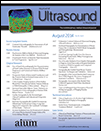Radial Artery Pseudoaneurysm
A Simplified Treatment Method
Matthew P. Cauchi DO
Department of Internal Medicine, Carilion Clinic, Roanoke Memorial Hospital, Roanoke, Virginia USA
Search for more papers by this authorCorresponding Author
Paul M. Robb MD
Department of Internal Medicine, Carilion Clinic, Roanoke Memorial Hospital, Roanoke, Virginia USA
Address correspondence to Paul M. Robb, MD, Department of Internal Medicine, Virginia Tech, Carilion Clinic School of Medicine, 1906 Belleview Ave, Roanoke, VA 24014 USA.Search for more papers by this authorRobert P. Zemple MD
Department of Emergency Medicine, Carilion Clinic, Roanoke Memorial Hospital, Roanoke, Virginia USA
Search for more papers by this authorTimothy C. Ball MD, PhD
Department of Cardiology, Carilion Clinic, Roanoke Memorial Hospital, Roanoke, Virginia USA
Search for more papers by this authorMatthew P. Cauchi DO
Department of Internal Medicine, Carilion Clinic, Roanoke Memorial Hospital, Roanoke, Virginia USA
Search for more papers by this authorCorresponding Author
Paul M. Robb MD
Department of Internal Medicine, Carilion Clinic, Roanoke Memorial Hospital, Roanoke, Virginia USA
Address correspondence to Paul M. Robb, MD, Department of Internal Medicine, Virginia Tech, Carilion Clinic School of Medicine, 1906 Belleview Ave, Roanoke, VA 24014 USA.Search for more papers by this authorRobert P. Zemple MD
Department of Emergency Medicine, Carilion Clinic, Roanoke Memorial Hospital, Roanoke, Virginia USA
Search for more papers by this authorTimothy C. Ball MD, PhD
Department of Cardiology, Carilion Clinic, Roanoke Memorial Hospital, Roanoke, Virginia USA
Search for more papers by this authorAbstract
A radial artery pseudoaneurysm represents a rare, potentially catastrophic complication of arterial cannulation that has been reported after cardiac catheterization. Treatment options are limited to chemical, mechanical, and combined approaches to obliterate the radial artery pseudoaneurysm and tract. Manual compression protocols using the TR Band (Terumo Medical Corporation, Somerset, NJ) have been variable and anecdotal, without objective measurements of adequate compression, making this technique prone to failure. In this report, we present an efficient, safe, and noninvasive management protocol using a pulse oximeter and the TR Band for treatment of radial artery pseudoaneurysms that is cost-effective and efficient and ensures correction without occlusion of the radial artery.
References
- 1Blasco A, Oteo JF, Fontanilla T, Salamanca J, Ocaranza R, Goicolea J. Unusual complications of cardiac catheterization via the radial artery [in Spanish]. Rev Esp Cardiol 2005; 58: 1233–1235.
- 2Hamid T, Harper L, McDonald J. Radial artery pseudoaneurysm following coronary angiography in two octogenarians. Exp Clin Cardiol 2012; 17: 260–262.
- 3Nasiri B, Alizadehasl A, Billejani I, Abdolrahman R, Toluey M. A complicated radial artery pseudoaneurysm. J Cardiovasc Thorac Res 2010; 2: 47–50.
- 4Eichhofer J, Horlick E, Ivanov J. Decreased complication rates using the transradial compared to the transfemoral approach in the percutaneous coronary intervention in the era of routine stenting and glycoprotein platelet IIb/IIIa inhibitor use: a large single-center experience. Am Heart J 2008; 156: 864–870.
- 5Pero T, Herrick J. Pseudoaneurysm of the radial artery diagnosed by bedside ultrasound. West J Emerg Med 2009; 10: 89–91.
- 6Pozniak MA, Mitchell C, Ledwidge M. Radial artery pseudoaneurysm: a maneuver to decrease the risk of thrombin therapy. J Ultrasound Med 2005; 24: 119–122.
- 7D'Achille A, Sebben RA, Davies RP. Percutaneous ultrasound-guided thrombin injection for coagulation of post-traumatic pseudoaneurysms. Australas Radiol 2001; 45: 218–221.
- 8Reeder SB, Widlus DM, Lazinger M. Low-dose thrombin injection to treat iatrogenic femoral artery pseudoaneurysms. AJR Am J Roentgenol 2001; 177: 595–598.
- 9Cope C, Zeit R. Coagulation of aneurysms by direct percutaneous thrombin injection. AJR Am J Roentgenol 1986; 147: 383–387.
- 10Kang SS. Percutaneous thrombin injection of pseudoaneurysms. J Vasc Interv Radiol 1999; 10(suppl): S192–S194.
10.1016/S1051-0443(99)71087-0 Google Scholar
- 11Kang SS, Labropoulos N, Mansour MA. Expanded indications for ultrasound-guided thrombin injection of pseudoaneurysms. J Vasc Surg 2000; 31: 289–298.
- 12Pezzullo JA, Dupuy DE, Cronan JJ. Percutaneous injection of thrombin for the treatment of pseudoaneurysms after catheterization: an alternative to sonographically guided compression. AJR Am J Roentgenol 2000; 175: 1035–1040.
- 13Liau CS, Ho FM, Chen MF, Lee YT. Treatment of iatrogenic femoral artery pseudoaneurysm with percutaneous thrombin injection. J Vasc Surg 1997; 26: 18–23.
- 14Kang SS, Labropoulos N, Mansour MA, Baker WH. Percutaneous ultrasound guided thrombin injection: a new method for treating postcatheterization femoral pseudoaneurysms. J Vasc Surg 1998; 27: 1032–1038.
- 15Wixon CL, Philpott JM, Bogey WM, Powell CS. Duplex-directed thrombin injection as a method to treat femoral artery pseudoaneurysms. J Am Coll Surg 1998; 187: 464–466.
- 16Taylor BS, Rhee RY, Muluk S. Thrombin injection versus compression of femoral artery pseudoaneurysms. J Vasc Surg 1999; 30: 1052–1059.
- 17Brophy DP, Sheiman RG. Pseudoaneurysm treatment with ultrasound-guided percutaneous thrombin injection. J Vasc Interv Radiol 1999; 10(suppl): S257.
- 18Partap VA, Cassoff J. Ultrasound-guided percutaneous thrombin injection for treatment of femoral pseudoaneurysm: technical note. Can Assoc Radiol J 1999; 50: 182–184.
- 19Brophy DP, Sheiman RG, Amatulle P, Akbari CM. Iatrogenic femoral pseudoaneurysms: thrombin injection after failed US-guided compression. Radiology 2000; 214: 278–282.
- 20Liou M, Tung F, Kanei Y, Kwan T. Treatment of radial artery pseudoaneurysm using a novel compression device. J Invasive Cardiol 2010; 22: 293–295.
- 21Schaub F, Theiss W, Busch R, Heinz M, Paschalidis M, Schömig A. Management of 219 cases of postcatheterization pseudoaneurysm. J Am Coll Cardiol 1997; 30: 670–675.
- 22Fellmeth BD, Roberts AC, Bookstein JJ. Postangiographic femoral artery injuries: nonsurgical repair with US-guided compression. Radiology 1991; 178: 671–675.
- 23Sheikhzadeh A, Hakim H, Ghabusi P, Ataii M, Tarbiat S. Right pulmonary artery-to-left atrial communication: recognition and surgical correction. Am Heart J 1984; 107: 396–398.
- 24 Terumo Medical Corporation. TR Band radial compression device [product handout]. Terumo Interventional Systems website. http://www.terumois.com/administration/pdfs/collateral%20library/TR%20Band%20Sell%20Sheet.pdf. Accessed November 14, 2013.
- 25 Terumo Medical Corporation. TR Band radial compression device. Terumo Interventional Systems website. http://www.terumois.com/products/sheaths/trband.aspx?page=closer. Accessed November 14, 2013.
- 26 Terumo Medical Corporation. Image adapted from: TR band (video): radial artery compression device for post-transradial procedures. Angiosoft.Net website. http://www.angiosoft.net/news_release5.php. Accessed November 14, 2013.
- 27Cozzi DA, Morini F, Casati A, Pacilli M, Salvini V, Cozzi F. Radial artery pseudoaneurysm successfully treated by compression bandage. Arch Dis Child 2003; 88: 165–166.




